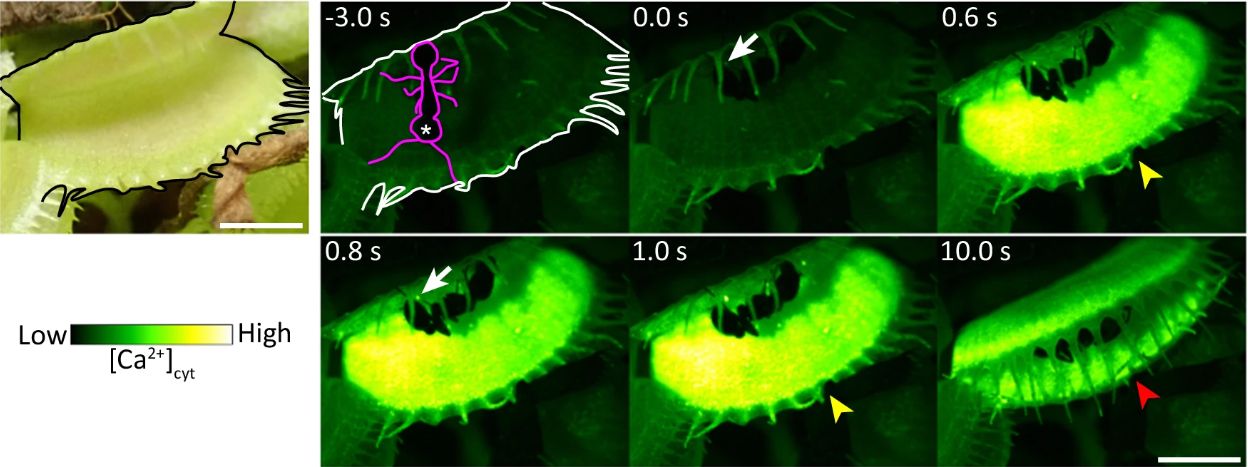Science
New Study Reveals Venus Flytrap Mechanosensor Boosts Prey Detection

Research published in Nature Communications has shed light on the mechanisms that allow the Venus flytrap, known scientifically as Dionaea muscipula, to swiftly capture its prey. The study, led by Hiraku Suda and his colleagues, identifies a specific mechanosensor, termed DmMSL10, which plays a crucial role in the plant’s rapid response to stimuli.
The Venus flytrap utilizes a spring-loaded mechanism to trap insects. Unlike other carnivorous plants, such as the waterwheel plant (Aldrovanda vesiculosa), which reacts more slowly, the Venus flytrap can close its leaves within a fraction of a second. Despite previous knowledge that calcium threshold signals trigger this response, the precise workings of the plant’s sensitivity had remained largely speculative until now.
Mechanism Unveiled
The study reveals that the DmMSL10 mechanosensor is integral to the plant’s ability to detect slight movements. Researchers created a knockout version of the plant where this stretch-activated chloride ion channel was absent. Observations showed that while both wild-type and knockout plants responded to mechanical stimulation, the knockout variant exhibited a significantly reduced action potential generation rate. The wild-type plants continued to generate action potentials even after stimulation ceased, underscoring the importance of DmMSL10 in prey detection.
To further corroborate their findings, the team conducted experiments in which ants were allowed to roam on the leaves of both wild-type and knockout plants. The wild-type Venus flytrap successfully captured the first ant that stepped onto its leaf, while the knockout variant failed to respond to four successive ants. This stark contrast in responses highlights the sensor’s critical role in enabling the plant to trigger calcium signals necessary for trapping prey.
Implications for Future Research
This discovery not only clarifies how D. muscipula processes stimuli but also opens avenues for further research into how similar mechanisms may have evolved in other organisms, including animals. Understanding the evolutionary pathways of such mechanisms can provide deeper insights into the adaptive strategies of carnivorous plants.
The findings from this study are expected to pave the way for additional investigations into the fascinating interactions between plants and their environments, particularly how certain plants have developed such advanced mechanisms to thrive in nutrient-poor soils. The ongoing exploration of the plant kingdom continues to reveal the intricate relationships between biology and adaptation, enhancing our appreciation for nature’s diversity.
-

 Health4 days ago
Health4 days agoRare Brain Condition Discovered More Common in New Mexico
-

 Politics5 days ago
Politics5 days agoPrince Andrew Steps Back from Royal Duties Following Epstein Memoir
-

 Health5 days ago
Health5 days agoRemembering Mary Ingleby: A Life of Love, Teaching, and Music
-

 Sports5 days ago
Sports5 days agoMLS Decision Day 2025: Playoff Spots on the Line as Teams Clash
-

 Science5 days ago
Science5 days agoIdaho State University Launches Haunted Science Laboratory on Oct. 25
-

 World5 days ago
World5 days agoYoung Driver Dies in Collision with Box Truck in El Cajon
-

 Lifestyle5 days ago
Lifestyle5 days agoKent Hamilton Named Southeastern Farmer of the Year at Expo
-

 Business5 days ago
Business5 days agoFirst National Bank of Groton’s Quiet Period Ends October 21
-

 Entertainment5 days ago
Entertainment5 days agoTrump Commutes George Santos’ Sentence, Sparks Controversy
-

 Politics5 days ago
Politics5 days agoNavy Veteran Max Quattromani Launches Campaign for Assessor Seat
-

 Sports5 days ago
Sports5 days agoSaquon Barkley Reacts to James Franklin’s Dismissal from Penn State
-

 World5 days ago
World5 days agoNevada Treasury Awards 2025 Kenny C. Guinn Memorial Scholarships









